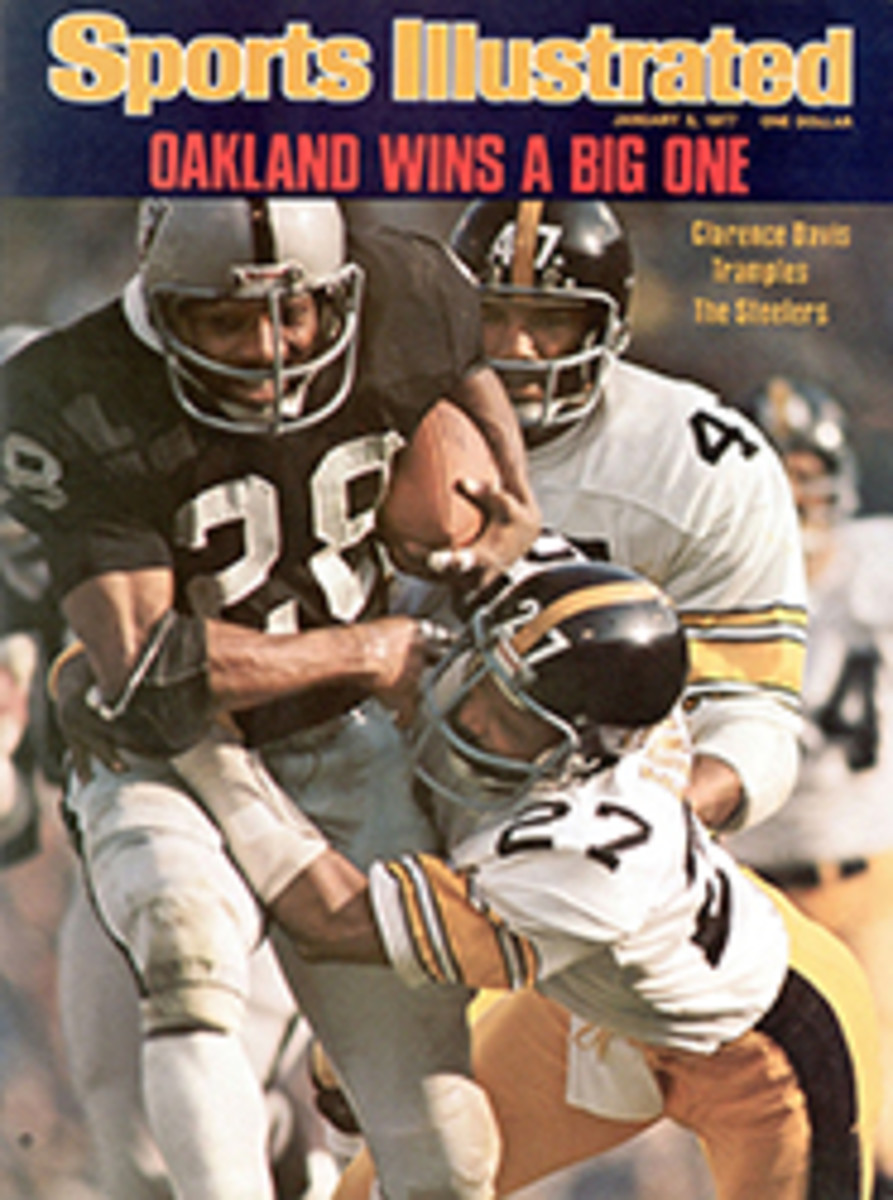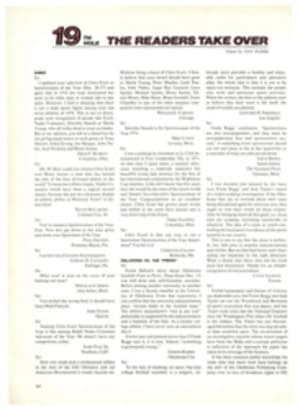
A Wise man and his gift
There was the unmistakable flavor of the Olympics in the air—national flags waving from their masts, tongue-twisting names on the entry list, world-class racers in the field. Yet, stirred in with this heady stuff was a weird mixture of sounds and sights: the boom of Indian drums and the jangle of their dance bells, the cacophony of singles bar chatter, the howl of wolves in the woods, the shouts of small children. And everywhere there was learned babble on the occult science of ski waxing—in Finnish, Norwegian, German and the flat inflections of Vermont English.
It was bizarre, yet somehow all of it blended together in astonishing harmony last week in the north woods of Wisconsin during an event that carried the unlikely label of the Gitchi Gami Games. The name (Longfellow called it Gitchee Gumee in "Hiawatha") is derived from Ojibwa and means "Great Waters," and the Gitchi Gami Games were at once sizable, consequential and dependent upon frozen water, being the most prestigious Nordic ski-racing contest in the United States since the Squaw Valley Olympics in 1960. The games attracted a field of European cross-country skiers the likes of whom never assemble outside their native continent except when an Olympics demands it. For most Americans, their names had all the impact of those on a page torn from the Helsinki phone book, but in Scandinavia and Central Europe they belong to heroes. There were the Finns: Arto Koivisto, Matti Pitkaenen, Juhani Repo; the Norwegians: Oddvar Brå, Odd Martinsen, Magne Myrmo; Thomas Magnuson of Sweden: Franz Renggli of Switzerland and Georg Zipfel of West Germany. Perhaps the only familiar face was that of the young American hero of Innsbruck, Billy Koch, whose silver medal in the 30-kilometer Olympic race may have been regarded as a miracle by the uninformed in the U.S. but was hardly that shocking to European cross-country fans who had seen Billy coming on for a couple of years.
The U.S. has never been much more than a tagalong in world-class races (before Koch's second, no American had ever been better than 15th in an Olympic cross-country event). Consequently, Europeans have viewed U.S. Nordic-style skiing with scorn—or not viewed it at all. Thus it was surprising that they should deign to come to this cross-country wasteland—to a remote place called Telemark in the far reaches of northwest Wisconsin. To be sure, the race, a 15-kilometer event, had been sanctioned by the Fédération Internationale de Ski. It was also an official event on the Nordic World Cup schedule for 1976-77. This is the relatively new (it is in its fourth season) and controversial series that offers racers a chance to accumulate points over a 14-race international season, and helps produce a ranking of the world's best skiers. It is similar to the Alpine World Cup circuit, but the Scandinavian countries have refused to sanction the formula, saying they would participate at Telemark only if the words "World Cup" were never, never used. So last week's race was called the American Cup, even though it was in truth a World Cup event—and a landmark in that it was the first ever held in America.
However, the question remains: What induced Europe's cross-country stars to come 4,000 miles for a race completed in little more than 40 minutes before only a couple of hundred people from Wisconsin? The answer lies in the imagination—and the wallet—of one Tony Wise, a bulky, round-faced, 55-year-old promoter/entrepreneur who has run the Telemark ski area for almost 30 years.
In 1947 Tony Wise bought a small swelling of glacial moraine 18 miles north of Hayward, Wis. for $750, got a war-surplus Jeep engine to run a rope tow and went into the ski-resort business. Although it is a celebrated joke around the Midwest that Telemark is the only ski area in the world where the lodge is bigger than the mountain, the 370-foot hill attracted many Plains States skiers. But not enough to maintain itself by skiing alone, and Wise had to rely on the splashy 'promotion, the clever gimmick. He hired big-name performers—from Duke Ellington to Chubby Checker. He threw an annual dinner called the Blue Ox Feast. He created a mass citizens' cross-country race, the American-Birkebeiner, which has come to be the U.S.' largest (it will probably draw 3,000 in February). In 1972 he began adding a network of cross-country trails (now close to 60 miles), and last year the U.S. team held its Olympic Trials at Telemark—largely because it had not snowed at Lake Placid, the original training site. Logically or not, all of this caused Tony Wise's imagination to percolate, and he came up with the idea of holding a world-class race at Telemark. "I was trying to think of a vehicle to promote the Birkebeiner Race," he says, "and this is what came to mind."
Fair enough. To hold such a race, all Wise had to do was 1) get himself a world-class cross-country course and 2) entice a field of world-class racers to show up in Wisconsin. Being a man of direct action, Wise decided that the quickest way to do this was to spend money. Which he did. He spent $100,000 last summer to build a spectacular new series of racing trails. They were designed by the U.S. team coach, Marty Hall, a veteran of many years on the international circuit, and they wind through the woods in a classic arrangement of chilling downhill drops (skiers reach speeds of 40 mph) and killing uphill climbs that drew gasping praise from the experts. John Caldwell, a former Olympian and coach who has long been one of America's best-known cross-country authorities, says that Telemark now has the finest trail network in this country, and Koch says that even in Europe the only course superior to Telemark's is the Olympic trail at Seefeld.
To get the racers, Wise put up another $60,000 for their plane fares, three days' lodging and food—everything from the moment they left home until they returned. He paid for the top U.S. skiers as well. Wise put everyone up at his Telemark Lodge, an eclectic place geared for every kind of guest from families who cook in their rooms to singles on the prowl through the cavernous carpeted lobbies, bars and ballrooms. Because Tony's psyche is perhaps charged a little more with the spirit of P. T. Barnum than that of Ull, the Norse ski god, he laid on an entertainment package that included several dozen Ojibwa Indians in full feather doing ceremonial dances, and he gave out lavish gifts, including fur-lined deerskin gloves made by the Indians.
When Wise had completed his preparations, the quality of the field was not in doubt. World Cup rules require that at least 10 racers who earned 20 or more points the previous season must be in the field for a race to be sanctioned. At Telemark there were 16, including Koivisto, who was No. 2; Myrmo, No. 4; Brå, No. 6; Repo, No. 7; and Koch, No. 8. Koch said, "There are only three World Cup races all this season that will be as good as this one. They are all in Scandinavia at the end of the season."
Of course, much of the attention—and the pressure—was on the 21-year-old Koch to deliver something spectacular in his first major American race. It was a lot to expect. Few young men have ever undergone such a wrenching transformation in life-style as Billy Koch has since winning his silver medal. Less than a year ago he was an intense, ascetic young man, perhaps bordering on the reclusive, who seemed to enjoy the loneliness, the introspection, even the selfless suffering of cross-country skiing. Then he became an instant star, and his shell of solitude was shattered. His days were filled with promotional appointments, contract negotiations and pleas for interviews and autographs. These interrupted his concentration and disrupted his training. A month or so before Telemark he suffered a debilitating reaction to medication he was taking for a chronic asthmatic condition, an excruciating malady for a cross-country racer in that it is severely aggravated both by extreme exertion and by cold weather. Koch, who is 5'11" and normally weighs 165, lost 15 pounds at one point. The week before the race he caught a cold. And the disastrous shortage of snow in the U.S. caused him and the rest of the American team to complete only about half of the on-snow training they had last year at the same time. The U.S. Nordic team director, John Bower, said before the race, "I don't see how Billy can do anything very impressive. I'd have to say his chances are pretty slim—but I've seen him surprise the heck out of everyone before."
The day of the American Cup race was partly cloudy, and the course was not particularly fast. And whatever you wanted to call it, the event did not belong to America. From the start, Koch looked oddly limp, grim and determined but obviously far off form. In a field of 78, which included dozens of American and Canadian rookies, he struggled to finish 27th and will not enter any more World Cup races until he has fully recuperated. Europeans swept the first nine places. The winner was Pitkaenen, a member of Finland's 1976 gold-medal Olympic relay team, who completed the course in 43:32.7. Br√• was second in 43:50.6, followed by two more powerful Finns, Repo and Koivisto. The best American finish—and a very good one in such a select field—was 10th by Stan Dunklee, 22, of Brattleboro, Vt., a U.S. team member since 1974 who had never before placed higher than 27th in an international race. Tim Caldwell, 22, of Putney, Vt., who finished 15th, was the only other American in the top 20.
Despite the relative mediocrity of the American performances at Telemark last week, the race itself was a milestone. Everything about the Gitchi Gami Games was world-class (with the possible exception of the name), and Tony Wise has every intention of staging it again next year—and for a long time to come. He said, "We're like Green Bay with the Packers. We may be a small town in a remote place, but we got here first—and we're going to stick with it."
TWO PHOTOS
Telemark's Tony Wise mixed moxie and money to create the "American Cup," and Finland's Matti Pitkaenen led a European sweep of the first nine places in the 15-kilometer cross-country race.

